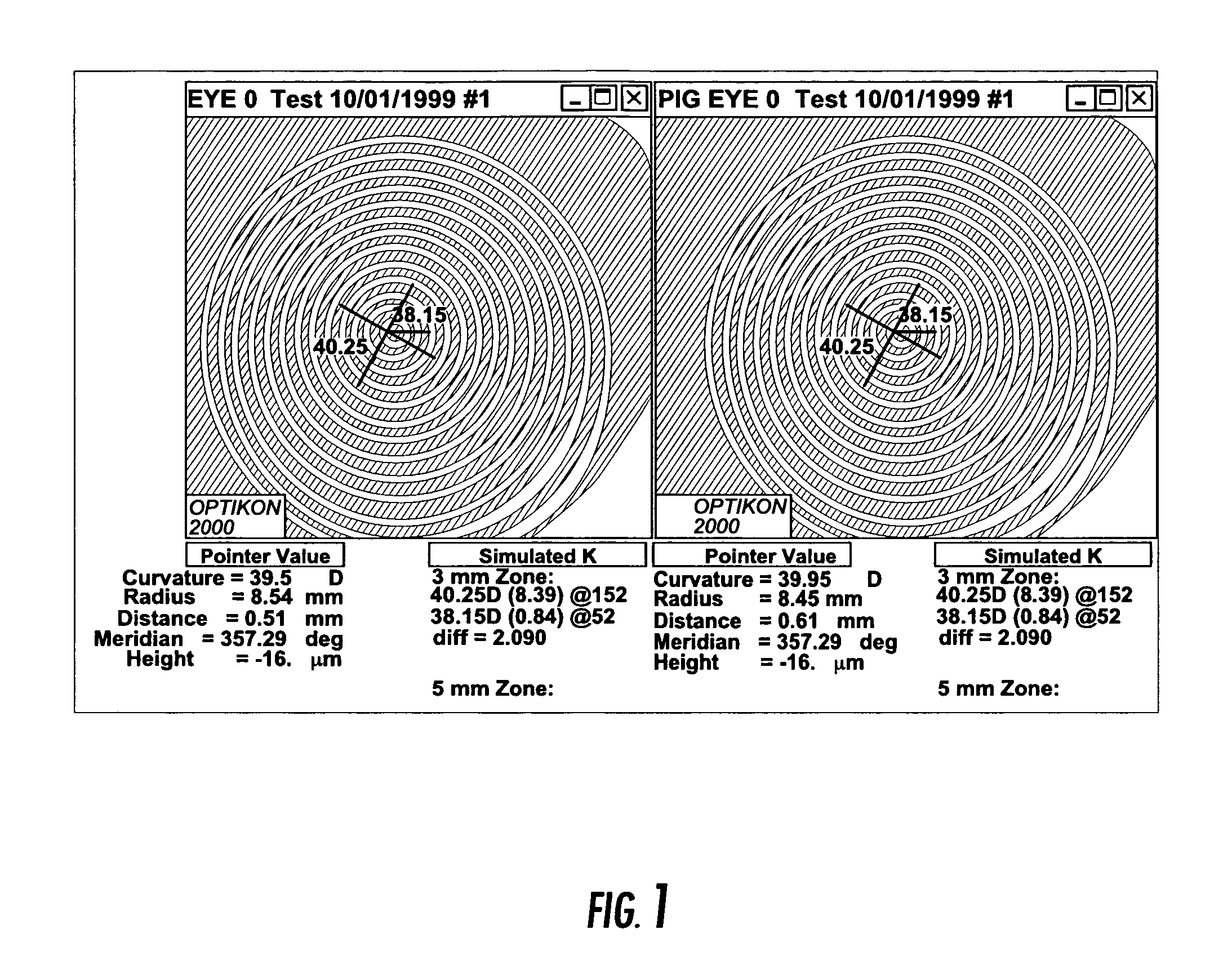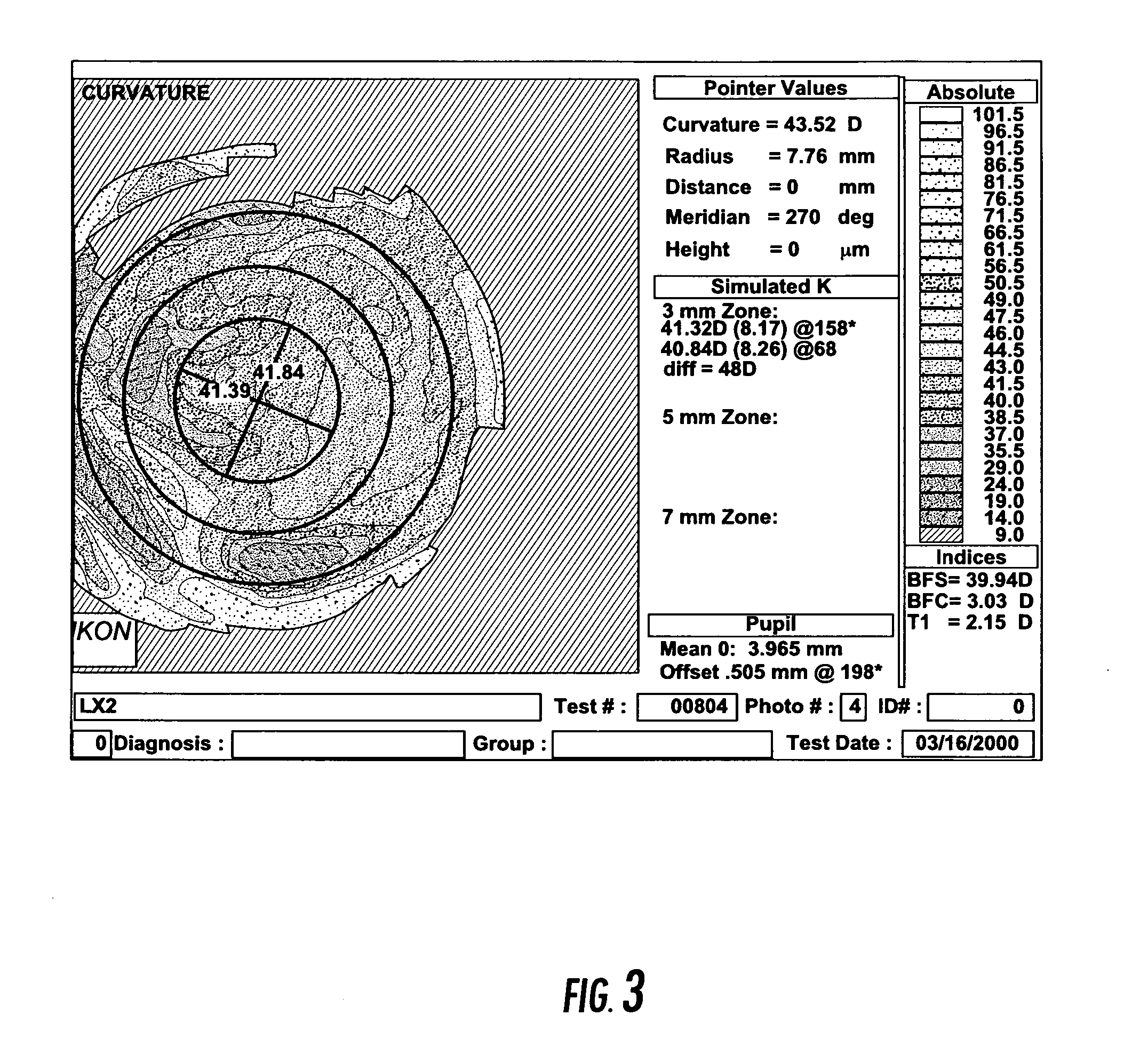Chemical treatment of in vivo tissue to alter charge and net charge density characteristics
- Summary
- Abstract
- Description
- Claims
- Application Information
AI Technical Summary
Benefits of technology
Problems solved by technology
Method used
Image
Examples
example 1
Enucleated Porcine Eyes
[0034] Eyes were procured from a local slaughterhouse, positioned in a device to stabilize the eye and subjected to topographical evaluation using the Optikon 2000 system. The corneal surface was dried using sterile gauze and then wetted with drops of buffer solution. The wetted eyes were again dried and exposed again to the same solution. Then a peripheral ring around the circumference of the corneal surface, slightly away from the limbus and the central cornea, was carefully treated by adding drops of buffer containing the active agent, a 20 mg / ml solution of glutaric anhydride. The eyes were then reexamined topographically and photos taken. Following evaluation, the eyes were placed in OptiSol for storage pending additional evaluations. Three eyes were treated using this protocol. In two eyes the active agent at 20 mg / mL was applied to a ring around the corneal periphery. The exposure width was approximately 1 mm. In one eye the active agent at 20 mg / mL wa...
example 2
In Vivo Cat Model
[0038] Two cats were treated with the active agent, glutaric anhydride. Treatment was applied to the right eye (OD) while the contra lateral eye (OS) served as a control. Buffer solution (0.02M disodium phosphate solution at pH 9.0) was first applied to the corneal surface. This was immediately followed by application of a solution of glutaric anhydride in disodium phosphate into a peripheral ring of a corneal mold placed on the corneal surface. The mold provided a tight seal to prevent migration of the active agent to the central cornea. Two treatment applications were provided at Day 1 and Day 7. The dosage of the active agent was 50 mg / mL. Eyes were examined for another 7 days following the second treatment.
[0039] As reported in the following Table 2, results from topographical evaluation show that refractive power (D) of the treated eye for Cat 1 reduced from 43.65 to 38.88 (4.77 Diopters). Results for Cat 2 showed a reduction from 42.83 to 40.68 (2.2 Diopters...
example 3
Treatment of Enucleated Porcine Eyes
[0041] Whole, fresh porcine (pig) eyes were obtained from a local abattoir and immediately placed in Optisol GS preservation solution. The whole eye was placed in a holder allowing the corneal surface to be exposed. A 7 mm trephine was used to cut through the epithelium and penetrate the superficial corneal tissue. The corneal surface was then flooded with 0.2M disodium phosphate solution, pH 9.0. After 1 minute, the surface of the cornea was dried using an absorbent wipe (Kim Wipe). The corneal surface was immediately treated with 0.2M disodium phosphate solution, pH 9.0, containing 50 mg / mL of glutaric anhydride. After 1 minute of exposure, the cornea was flushed with phosphate buffered saline, pH 7.2. The surface of the cornea was inspected and the corneal curvature examined and compared to untreated eyes. A white ring was observed at the trephine impression, even after several days. The central corneal surface was clearly depressed or flatten...
PUM
 Login to View More
Login to View More Abstract
Description
Claims
Application Information
 Login to View More
Login to View More - R&D
- Intellectual Property
- Life Sciences
- Materials
- Tech Scout
- Unparalleled Data Quality
- Higher Quality Content
- 60% Fewer Hallucinations
Browse by: Latest US Patents, China's latest patents, Technical Efficacy Thesaurus, Application Domain, Technology Topic, Popular Technical Reports.
© 2025 PatSnap. All rights reserved.Legal|Privacy policy|Modern Slavery Act Transparency Statement|Sitemap|About US| Contact US: help@patsnap.com



